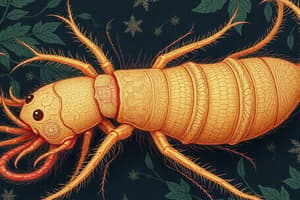Podcast
Questions and Answers
What is a distinguishing characteristic of ectoparasites?
What is a distinguishing characteristic of ectoparasites?
- They live on the exterior of the host. (correct)
- They live inside the host.
- They undergo a direct life cycle.
- They include single-celled organisms.
Which type of life cycle involves multiple host species?
Which type of life cycle involves multiple host species?
- Direct life cycle
- Indirect life cycle (correct)
- Complex life cycle
- Multiple life cycle
What is an example of a transmission route categorized as 'fecal-oral'?
What is an example of a transmission route categorized as 'fecal-oral'?
- Direct skin contact
- Insect vectors
- Mosquito bites
- Contaminated water (correct)
What defines a helminth?
What defines a helminth?
Which of the following is a direct effect of parasitic infections on hosts?
Which of the following is a direct effect of parasitic infections on hosts?
Which method is typically used for the molecular diagnosis of parasitic infections?
Which method is typically used for the molecular diagnosis of parasitic infections?
What is an example of a zoonotic parasite?
What is an example of a zoonotic parasite?
What is the main focus of public health measures in relation to parasitology?
What is the main focus of public health measures in relation to parasitology?
Flashcards are hidden until you start studying
Study Notes
Overview of Parasitology
- Definition: Parasitology is the study of parasites, their hosts, and the relationship between them.
- Types of Parasites:
- Ectoparasites: Live on the exterior of the host (e.g., ticks, lice).
- Endoparasites: Live inside the host (e.g., worms, protozoa).
Life Cycles of Parasites
- Direct Life Cycle: Involves one host species where the parasite undergoes development and reproduction.
- Indirect Life Cycle: Involves multiple host species; can include definitive hosts (where mature parasites reproduce) and intermediate hosts (where larvae develop).
Classification of Parasites
- Protozoa: Single-celled organisms (e.g., Plasmodium, Giardia).
- Helminths: Multicellular worms.
- Nematodes: Roundworms (e.g., Ascaris, Enterobius).
- Trematodes: Flukes (e.g., Schistosoma).
- Cestodes: Tapeworms (e.g., Taenia).
- Ectoparasites: Insects and arachnids.
Transmission Routes
- Vector-borne: Transmission via an intermediary organism (e.g., mosquitoes for malaria).
- Fecal-Oral: Transmission through contaminated food or water (e.g., Giardia).
- Direct Contact: Skin contact with infected hosts (e.g., scabies).
Host-Parasite Interactions
- Commensalism: One organism benefits, the other is neither helped nor harmed.
- Mutualism: Both organisms benefit.
- Parasitism: One organism benefits at the expense of the other.
Effects on Hosts
- Pathogenic Effects: Parasites may cause diseases (e.g., malaria, schistosomiasis).
- Nutritional Deficiencies: Competitively consume nutrients.
- Immune Response: Triggers host immune responses, which can lead to inflammation and tissue damage.
Diagnosis and Treatment
- Diagnostic Methods:
- Microscopy (stool examination, blood smears).
- Serological tests (antibody detection).
- Molecular methods (PCR).
- Treatment:
- Antiparasitic drugs (e.g., ivermectin, praziquantel).
- Preventive measures (e.g., sanitation, vector control).
Prevention and Control
- Public Health Measures: Education, sanitation, and hygiene.
- Control of Vectors: Insecticides, mosquito nets.
- Vaccination: Development of vaccines against certain parasites.
Emerging Topics in Parasitology
- Zoonotic Parasites: Parasites that can be transmitted from animals to humans.
- Antimicrobial Resistance: Increasing resistance of parasites to available treatments.
- Environmental Impact: Effects of climate change on parasite transmission dynamics.
Conclusion
- Parasitology is crucial for understanding infectious diseases, biodiversity, and ecosystem health.
- Ongoing research is vital for developing effective treatments and preventive measures against parasitic infections.
Parasitology: The Study of Parasites and their Hosts
- Parasitology focuses on the study of parasites, examining their interactions with their hosts.
- Ectoparasites live externally on the host (like ticks and lice), while endoparasites reside inside the host (such as worms and protozoa).
Understanding Parasite Life Cycles
- Parasites can have direct life cycles, involving a single host where development and reproduction occur.
- Indirect life cycles involve multiple hosts, including definitive hosts where mature parasites reproduce and intermediate hosts where larval stages develop.
Classifying Parasites
- Protozoa are single-celled organisms like Plasmodium (malaria) and Giardia.
- Helminths are multicellular worms.
- Nematodes are roundworms, including Ascaris and Enterobius.
- Trematodes are flukes, exemplified by Schistosoma.
- Cestodes are tapeworms, such as Taenia.
- Ectoparasites comprise insects and arachnids.
Transmission Pathways of Parasites
- Vector-borne transmission involves an intermediary organism carrying the parasite, like mosquitoes transmitting malaria.
- Fecal-oral transmission occurs through contaminated food or water, as seen with Giardia.
- Direct contact involves skin contact with infected hosts, such as in scabies.
The Interplay Between Hosts and Parasites
- Commensalism benefits one organism without harming the other.
- Mutualism benefits both organisms involved.
- Parasitism, the focus of parasitology, benefits one organism at the expense of the other.
Impact of Parasites on Hosts
- Pathogenic effects: Parasites can cause diseases like malaria and schistosomiasis.
- Nutritional deficiencies: Parasites can compete with their hosts for nutrients.
- Immune response: Parasites trigger host immune responses, potentially leading to inflammation and tissue damage.
Diagnosis and Treatment of Parasitic Infections
- Diagnosis:
- Microscopy (stool examination, blood smears)
- Serological tests (detecting antibodies)
- Molecular methods (PCR)
- Treatment:
- Antiparasitic drugs (e.g., ivermectin, praziquantel)
- Preventive measures (sanitation, vector control)
Preventing and Controlling Parasitic Infections
- Public health measures: Education, sanitation, and hygiene are crucial.
- Vector control: Insecticides and mosquito nets help prevent spread.
- Vaccination: Development of vaccines against certain parasites is ongoing
Emerging Challenges in Parasitology
- Zoonotic parasites: Parasites transmissible from animals to humans pose a threat.
- Antimicrobial resistance: Increasing resistance to available treatments is a concern.
- Environmental Impact: Climate change influences parasite transmission dynamics.
Conclusion
- Parasitology is vital for understanding infectious diseases, biodiversity, and ecosystem health.
- Continued research is crucial for developing effective treatments and preventive measures against parasitic infections.
Studying That Suits You
Use AI to generate personalized quizzes and flashcards to suit your learning preferences.




